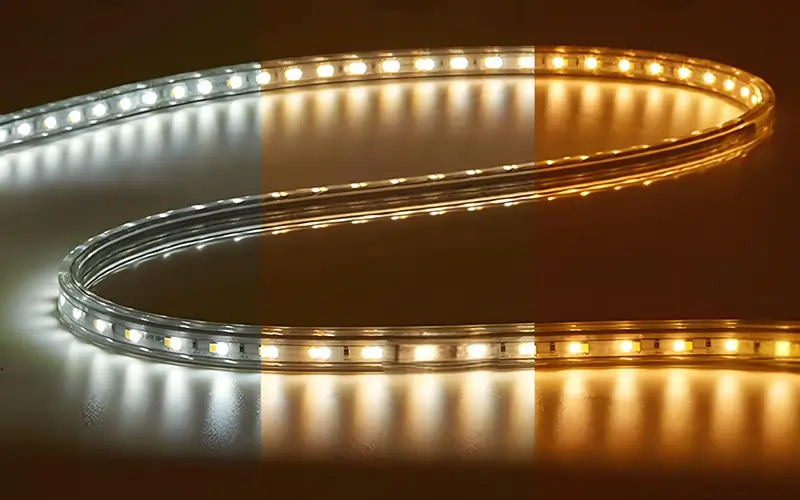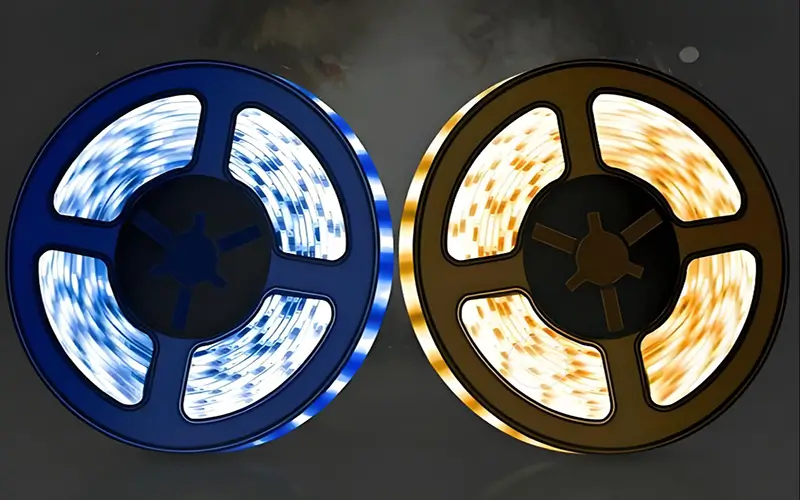What is the Difference Between Dim to Warm LED Strips and Tunable White LED Strips?
There are two popular types of LED strips on the market today: Dim to warm LED strips and Tunable White LED strips. They both offer unique benefits for different lighting needs. They both allow the user to adjust the color temperature of the lighting, but the way they achieve this is very different. This article will help clarify the differences between Dim Warm and Tunable White LED strips.
What Are Dim to Warm LED Strips?
Warm-to-dim LED strips are used for specific place lighting and their main function is to mimic the natural behavior of incandescent light.
As the brightness decreases, these LEDs gradually shift to a warmer color temperature, typically around 3000K to 1800K. This creates a cozy candlelight effect, perfect for creating a relaxing and warm atmosphere. If you wanna dim the LED strip, pls read How to Dim LED Strip Lights?

How Do Dim to Warm LED Strips Work?
How Dimmable Warming LEDs work is not complicated either. This is achieved by combining two groups of LEDs within a single strip.
When we dim, we adjust both the brightness and the color temperature. One group is for cool white light and the other for warm white light. As the dimmer is turned down, the warm LEDs become more dominant and the cool LEDs gradually dim, creating a soft amber glow.
Application of Dim to Warm LED Strips
- Residential Settings: mainly depends on the style of indoor living, which is warm color. It is very suitable for bedrooms, living rooms and dining areas to create a warm and pleasant atmosphere.
- Commercial Spaces: It is very suitable for retail stores, restaurants and hotels to enhance the atmosphere and create a memorable customer experience.
What Are Tunable White LED Strips?
Tunable white LED strips offer greater flexibility, combining two color temperatures. You can also order a single color temperature. It also allows users to adjust the color temperature and mix color temperatures independently of brightness.
With these tunable white LED strips, you can choose any color temperature within a predefined range, usually from cool white (about 6500K) to warm white (about 2700K), regardless of the brightness level.
How Do Tunable White LED Strips Work?
Tunable white LED strips contain two channels (one for warm white LEDs and one for cool white LEDs) that are independently controllable.
By adjusting the ratio of the two channels, users can precisely set the color temperature to suit their needs without compromising brightness. This flexibility enables a variety of lighting effects, from energizing cool white light during the day to soothing warm tones at night.

Application of Tunable White LED Strips
- Commercial Spaces: Great for offices, hospitals, and schools. We can use warm 2700K to improve well-being while also using 6000K to increase productivity.
- Industrial Settings: Tunable white LED strips are great for workshops and factories, improving visibility and reducing eye fatigue.
- Residential Settings: Home lighting is also a good choice. Tunable white LED strips can use in home offices, kitchens, and bathrooms to create a versatile and practical lighting environment.
Key Differences Between Dim to Warm and Tunable White LED Strips
| Feature | Dim to Warm LED Strips | Tunable White LED Strips |
| Color Temperature Range | Limited to a warm to warm white spectrum | Wide range of color temperatures, from warm white to cool daylight |
| Level of Control | Less control over color temperature | Greater control over both brightness and color temperature |
| Ideal Applications | Residential settings, creating a cozy ambiance | Commercial and residential settings, requiring versatile lighting solutions |
Which LED Strip Type is Right for Your Project?
You need to choose based on your project and the effect you want.
- Desired Ambiance: If you prioritize a warm and cozy atmosphere, then dim to warm LED strips are a good choice.
- Level of Control: f you need precise control over brightness and color temperature, and need to control them independently. Tunable white LED strips offer greater flexibility.
- Application: The specific application will determine the best type of LED strip. For example, tunable white LED strips are ideal for offices and workshops, while dim to warm LED strips are perfect for bedrooms and living rooms.
Conclusion
Understanding the meaning and difference between dim to warm and tunable white LED strips can help you choose the right lighting solution. At ESSENLED, we specialize in both types of lighting, providing high-quality, customizable LED strips. Our LED solutions come with a 5-year quality guarantee, ensuring durable and reliable lighting for your project.
FAQs
Dimmable-to-Warm LED Strips mimic the effect of a traditional incandescent light bulb. They change color temperature from cool white to warm yellow when dimmed. Tunable-white LED Strips, on the other hand, allow users to adjust color temperature over a wide range from cool white to warm white without affecting brightness levels. Dimmable-to-Warm provides a more natural, warmer glow.
Tunable-White LED Strip Lighting allows users to adjust color temperature between cool white (approximately 6000K) and warm white (approximately 2700K) independent of brightness. The light output is constant, only the color temperature changes. These LEDs can be adjusted for different moods or tasks.
No, because Dimmable-to-Warm and Tunable-White LED Strips perform different functions and use incompatible controllers. However, it is important to note that dimming to warm LEDs are designed to change color temperature when dimmed. While tunable white LEDs adjust color temperature without changing brightness.
Dimmable warm LED strips are best suited for environments that need to mimic the warm lighting of traditional incandescent lamps. And there are many places where this type of LED strip is needed. For example, living rooms, bedrooms, dining areas, and hospitality environments. These strips are great for creating cozy mood lighting that enhances relaxation and comfort.








